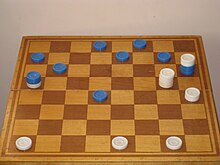Russian lady
The Russian checkers or Shashki (шашки) is a variant of the classic checkers game that is particularly widespread in Russia , the states of the former Soviet Union in Asia and in Eastern Europe . Like the classic checkers game, it is usually played on a chessboard with 64 fields, 8 × 8, but it differs from this in the possibilities of hitting the pieces: In contrast to the classic checkers, the pieces can hit both forwards and backwards.
Style of play
| a | b | c | d | e | f | G | H | ||
| 8th | 8th | ||||||||
| 7th | 7th | ||||||||
| 6th | 6th | ||||||||
| 5 | 5 | ||||||||
| 4th | 4th | ||||||||
| 3 | 3 | ||||||||
| 2 | 2 | ||||||||
| 1 | 1 | ||||||||
| a | b | c | d | e | f | G | H |
As with the classic checkers game, the Russian checkers is a board game for two players who sit across from each other on the game board. One player plays the white and the other the black pieces and the two players take turns making a move. In the starting line-up, the 12 pieces are set up on the black fields of the first to third rows on both sides of the game board.
The colors are drawn or chosen, the white player begins the game. Both players now alternately each draw a piece (Шашка), whereby the pieces may be moved diagonally forward on the black fields. When a player reaches the baseline on the opposite side, his checker becomes a queen (Дамка). This may move any number of fields in any diagonal direction, including backwards.
As with the classic checkers, a piece can be captured if an adjacent piece can jump over it onto a free field behind it. The Russian Queen is allowed to hit both forwards and backwards and it is compulsory to hit, so a stone must be hit if this is possible. If another stroke is possible from the new position, this is also carried out. The queen can capture any far away individual stones of the opponent, if there is a free space behind it, and also capture several stones one after the other. If a stone becomes a queen by capturing someone else and can then capture further stones directly as a queen, the move is also continued. All captured stones are removed from the playing field after the move.
As in the classic checkers game, the winner is the player who succeeds in capturing all of the opponent's stones or immobilizing them. It is also possible to win the game if the opponent only has one stone left.
Competitions
The official rules of the Russian Lady were first printed in Russia in 1884. The first Russian championship was held in 1894, the following three took place in 1895, 1898 and 1901. The first championship in the Soviet Union took place in 1924 and from 1924 to 1991 there were 51 men's and 35 women's championships. After the dissolution of the Soviet Union, championships were held in the Russian Federation, Ukraine, Belarus and other post-Soviet states.
The first World Championship in Russian Checkers took place in 1993 as part of the World Championship in Checkers-64 (Russian and Brazilian version - since 1985) under the patronage of Section 64 of the World Women's Sport Federation. The European Championship for Russian Checkers will be held as part of the European Draft-64 Championship (Russian and Brazilian variant) and at national championships.
Building game variants
Several other queen variants build on the Russian queen, including above all Bashni (turret lady ) and the Laska derived from it, as well as the Poddavki or Shashki Poddavki , which corresponds to the hit lady and in which the player who can no longer move wins.
Another variant of the game is played on a 10 × 8 board with 80 fields with two additional columns. The checkers grandmaster Vladimir Vigman also developed a variant in which each player has 24 pieces (two complete sets) and places them on the white fields and on the black fields. Each player then plays two games at the same time: one game on the white fields and another game on the dark fields, the total result is the sum of the results of both games.
supporting documents
- ↑ a b c d Russian Checkers (Drafts) In: Brian Burns (Ed.): The Encyclopedia of Games. Brown Packaging Books, 1998; P. 157.
- ↑ Rules for Shashki Poddavki in the Russian Lady Association (Russian), accessed on February 3, 2020.
literature
- Russian Checkers (Drafts) In: Brian Burns (Ed.): The Encyclopedia of Games. Brown Packaging Books, 1998; P. 157.
Web links
- Official rules of the International Drafts Federation
- Shashki in the game database BoardGameGeek (English)

